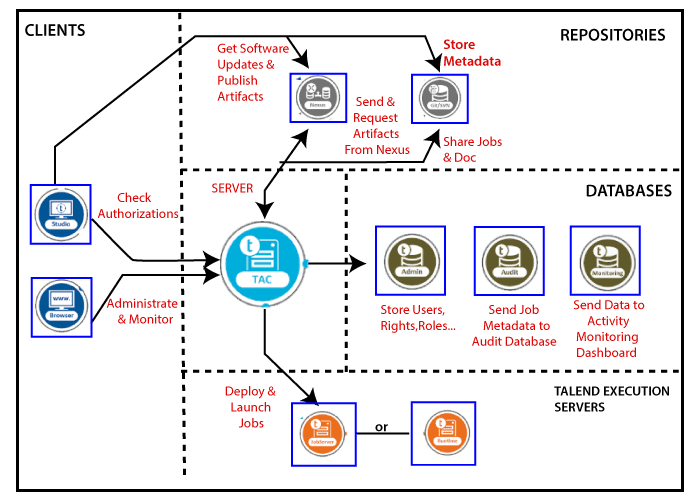Talend Data Integration Architecture
In this section, we will learn about the architecture of Talend open studio for Data integration platform.
The architecture model of Talend open studio identifies the Talend data integration functions, interactions, and corresponding IT needs.
The following image shows the architectural, functional blocks of a Data integration architecture:

Let us understand the various functional blocks of data integration architecture:
- Clients
- Servers
- Database
- Repositories
- Execution Servers
Clients:
- The client block is used for building and monitoring Talend Jobs.
- The client block can have one or more Talend studio(s), and the web browser that could be on the same or different machines.
- The Talend studio allows us to work on any project if we have the authorization.
- We can connect the remotely based Talend administration center through a secured HTTP protocol with the help of a web browser.
- We can also carry out the data integration process regardless of the level of data volumes and process the complexity from the studio.
Server:
- The server block is used for administration, management, and monitoring.
- The server block contains the web-based application server, whereas the Talend Administration Center is used to enable the management and administration for all the projects
- The administration metadata is stored in the administration database.
For Example: the user accounts, access rights, and project authorization.
- The data of project items like jobs, business models, and routines are stored in the SVN or a Git server.
Databases:
- The database is used to store the metadata and configuration information.
- The administration, the audit, and monitoring the databases come under the database block.
- The administration database is used to manage the user accounts, access rights, and project authorization, and so on.
- An audit database is used to check different conditions of the jobs, and implemented in a project and developed in the Talend studio.
Repositories:
- In the repositories block, we will host the project metadata and binaries.
- The SVN or Git server and the Nexus repository come under the repositories block.
SVN or the Git server: It is used to centralize all the project items like jobs and business models, which is shared between different end-users and also accessible from the Talend studio to develop the project item.
- And the Talend administration central is used to publish, deploy, and monitor the project
- The nexus repository is used to check whether the Software updates are available to download or not. And the job which is published from the Talend studio is ready to be deployed and executed.
Execution Server:
- The execution server is used for deploying and launching the jobs.
- The Talend execution server block is having one or more execution servers, which is deployed inside our information system.
- Talend jobs are deployed to the job servers through the Administration Center's job conductor, which is to be executed on a scheduled time, date, or event.
|

 For Videos Join Our Youtube Channel: Join Now
For Videos Join Our Youtube Channel: Join Now










